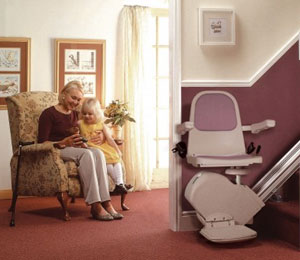Residential Stair Lifts
Stair lifts are an essential addition to any home in which the occupants have limited mobility. There can be many reasons for limited mobility such as injury, old age, arthritis or obesity, but whatever the reason may be, residential stair lifts allow these people to continue to stay in their home and use all of its floors and rooms. This can be a god’s send for people, who may be worried about otherwise having to move into sheltered accommodation or even a care home.
Back to Top
Things to Consider when Buying Residential Stair Lifts
If you are thinking about buying a residential stair lift, there are a few things that you should take into consideration.- Brand of residential stair lifts - There are many different manufacturers available and it is important to review the pros and cons of each brand, as well as their customer satisfaction level before deciding which stair lift to purchase.
- Size of the stair lift - Residential stair lifts are generally able to carry around 18 stone or 120 kilograms of weight. If reduced mobility is caused due to obesity, or if it is likely that significant weight gain will occur in the near future (for example due to pregnancy or medication), it may be necessary to consider heavy duty stair lifts. Installers will always ask you for the weight of the heaviest person that is likely to use the stair lift, and it is important to not lie on this question!
- Cost - The cost of residential stair lifts will depend on many things, such as the brand and the type. Generally, straight stair lifts that do not need to travel around any corners or bends are often much cheaper than curved stair lifts.
Different Types of Residential Stair Lifts
There are three main types of residential stair lifts. These are:- Straight stair lifts – these are for stairs that have no bends or corners
- Curved stair lifts –these are custom made to fit any stairs that do go around corners or bends
- Outdoor stair lifts – these are almost always straight stair lifts, designed specifically for outdoor use and made of more durable materials than their indoor counterparts.
- Perched stair lifts where the user faces away from the wall and is in a position between standing and sitting. These usually have some form of lower back support built in.
- Seated residential stair lifts that have a seat on which the user can sit.
- Standing stair lifts where the user faces the wall and travels up and down the stairs in a standing position.
Back to Top

